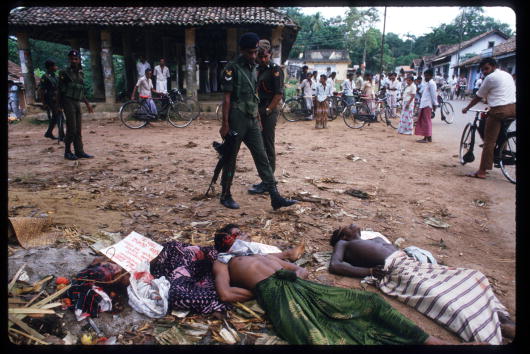Need for placing 88-89 events in perspective

Bodies of JVP followers killed by the PRRA lie on the ground with posters tied around their necks in Tihagoda. The sign says, ”This is the punishment for followers of the JVP signed by the PRRA.”
December 1989 (Photo by Robert Nickelsberg/Liaison)
December 1989 (Photo by Robert Nickelsberg/Liaison)
Science, Technology and Research Minister Susil Premajayantha has called for a full investigation into the events of 1988-89 which saw a blood bath in the country. Speaking during the budget debate in Parliament Premajayantha has urged for the appointment of a Commission to investigate the mass killings that took place during the period in question when the JVP staged its second uprising.
It is not clear if what the Minister meant was a probe on the JVP killing spree or the lives lost in the counter strike by vigilante groups or an amalgam. But a probe should necessarily encompass all the killings that took place, during one of the blackest chapters in the country's post independence history where rivers of blood flowed and the law and order machinery ground to a halt.
Those who lived through those traumatic days would recall the anarchic state to which the country plunged into where life lost its value, with corpses strewn at every street corner and floating in rivers, canals and waterways which also saw the birth of the 'tyre pyre' that subsequently became a popular mode for expression of dissent by street protesters. Shops were forced to put up shutters on receipt of a 'chit' delivered by the sparrow units of the JVP. Those who defied the edict had it coming to them, their bodies mutilated and publicly displayed in the most gory fashion with the inevitable sign attached to the body spelling out the fate that awaited the traitors.
Unlike in 1971, the initial foray of the JVP to grab state power, the second uprising took a most virulent form exacting a heavy toll of lives and state property. This is largely due to the most sophisticated weapons that were in use in 1988-89, what with the Eelam war at its height, compared to the primitive weaponry that the JVP fighters had to make do with in 1971.
The Opposition at the time went to town blaming the UNP Government and particularly President Premadasa for the carnage, blinding itself to the fact that it was the UNP supporters, local activists and party office bearers who were the prime targets of the Deshapremi Janatha Viyaparaya, the military wing of the JVP, which was later extended to the left parties which supported the Indo-Lanka Accord, with Vijaya Kumaratunga being the most high profile victim.
Be that as it may, the UNP had the 1988-89 period thrown at its face at every election that followed, with CBK chanting the famous Dooshanaya, Beeshanaya manthra successfully to win elections. The UNP known as a staid, moderate and conservative party was demonized with its profile taking a huge beating which contributed in no small measure to its serial defeats at the hustings.
But the truth needs to be put in their proper perspective in order to come to terms with that unfortunate period where tens of thousands lost their lives in the mindless blood letting. True, the Government of the day took counter terrorism measures to halt the anarchy and some may question the means adopted in this regard. However looking at things from another perspective, a legitimate Government is duty bound to defend the country from threats both within and without. It also has to take measures to prevent the country slipping into anarchy. Besides what was under assault was the democratic system itself and had the Premadasa Government allowed things to drift without taking effective measures to halt the anarchy, democracy itself would have been in peril. Just as Mrs. Bandaranaike did in 1971 Premadasa was compelled to take drastic measures. As already mentioned more lives may have been lost, but this should be viewed in context, considering that a full blown terrorist war was on with availability of sophisticated weapons such as the T56 and AK 47 in the hands of the JVP.
There was an element that was not witnessed in 1971, namely the tit for tat attacks carried out by the JVP in 88- 89 targeting family members of army and police personnel, the last straw that broke the camels back leading to a no holds barred assault on the JVP ending in its liquidation.
Minister Premajayantha, whatever his motive, should be commended for suggesting the appointment of a Commission to probe this ugly chapter in post independence Sri Lanka, if for no other reason than to vindicate the Premadasa's Government's action in protecting democracy. Desperate situations calls for desperate solutions. It certainly was not a clean counter terrorism operation. Many innocents perished, as could be expected in a blood bath of such a magnitude. But those who suffered the most were the members and activists of the UNP which in some instances had their entire families wiped out. The Commission, it is hoped will do justice to the survivors of these hapless victims from far flung villages, who braved the odds to preserve the democratic way of life. The UNP as a party too should be cleansed of the stigma attached to it for defeating an anarchic force, instead of continuing to be pilloried for the actions it took towards this end, even if these were not always according to Queensbury Rules.

